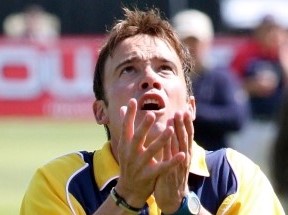Specialist fielding: Boundary fielding
 Fielding in the deep can feel like a lonely place.
Fielding in the deep can feel like a lonely place.
There you are with acres of space to sprint around while the batsman gives it the long handle.
Then they smash one straight up in the air and you have to wait forever for it to come down into your hands.
The potential for a mess up is a high one. Yet, you can massively reduce the chances of things going wrong simply by working on your specialist skills in this area.
Why have boundary fielders?
Being on the rope is a simple task, if a physically and mentally demanding one. Your job is to stop the ball going for a boundary, keeping the number of runs the batsman scores as low as possible.
More occasionally, and dramatically, you will be required to catch the ball.
This means you need to be able to pick up balls early, run to them quickly (often having to slide to get there) and return them with an accurate throw. If that wasn’t enough you also need to be brave with strong catching hands.
You might find yourself anywhere between deep point and deep square leg. The off side has fewer catches (it’s easier to sky a ball to leg).
Where to stand: On the rope?
Traditional coaching has stuck to a simple idea: Boundary fielders stand on the boundary line.
To creep in too far is a schoolboy error and makes you look silly when it goes over your head but bounces inside the rope to go for four.
Mostly you will want to follow the orthodox line, but there are times when you have to judge where to stand with a bit more nous. Here are some times you may want to drift away from that rope:
- A batsman you know has a big ego and thinks he can clear you so you wander in to tempt him to go over the top.
- A very long boundary (especially on the off side) that batsmen will struggle to hit boundaries.
- In the middle overs of a limited over match when the batsmen are not hitting out but working the ball around and looking to turn singles into twos.
How to field on the boundary
Wherever you stand, fielding in the deep requires you to stay focused. It’s rare for the captain to put you out unless the ball is going to the boundary.
As the bowler is delivering the ball, watch the batsman for clues to the shot that is coming your way. If it’s clear they are aiming for the area you are covering, laser your focus in on the ball.
You have to make quite a few quick decisions when you realise the ball is coming your way.
If it’s along the ground, your job is to get to the ball as quickly as possible and, if needed, stop the boundary. What happens next depends on what the batsmen are doing.
- If they are risking an extra run, attack the ball and return it quickly. This is a riskier approach because more can go wrong, especially in crucial moments (but that’s OK because as a specialist you will have practiced).
- If they are strolling and not looking to score, take more time returning the ball so your throw is accurate.
If the ball is coming in the air you have to quickly judge if it is going to reach you or not.
If it is, get in position to catch it, steady yourself and catch the ball with strong hands.
If it’s going to bounce, watch how the ball is spinning, adjust and look to take it after the first bounce if you can. Again the return needs to be accurate.
Ways to practice
Boundary fielding is, more than any other, the execution of fielding skills in an ever changing game environment.
So while it’s important to drill to get your technique right, you also need to practice with a bit of chaos and game situation feeling. Here are some drills that should be done as often as possible (every day if you can):
Keeping score in these drills makes sure there is pressure on you to perform too.
Also use middle practice as this simulates batsmen trying to steal extra runs from you.
- Login to post comments

